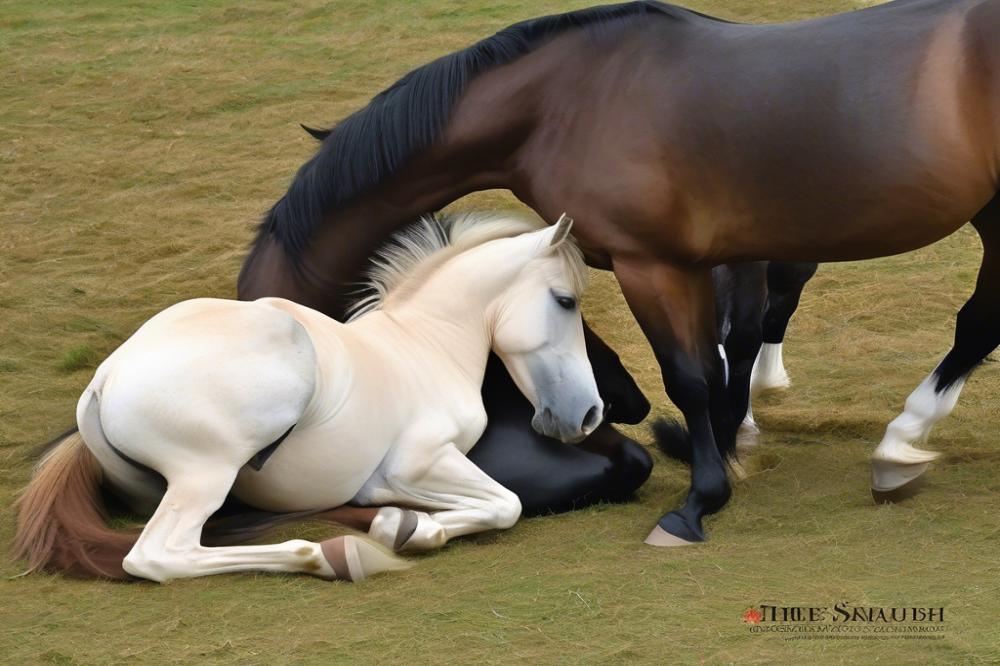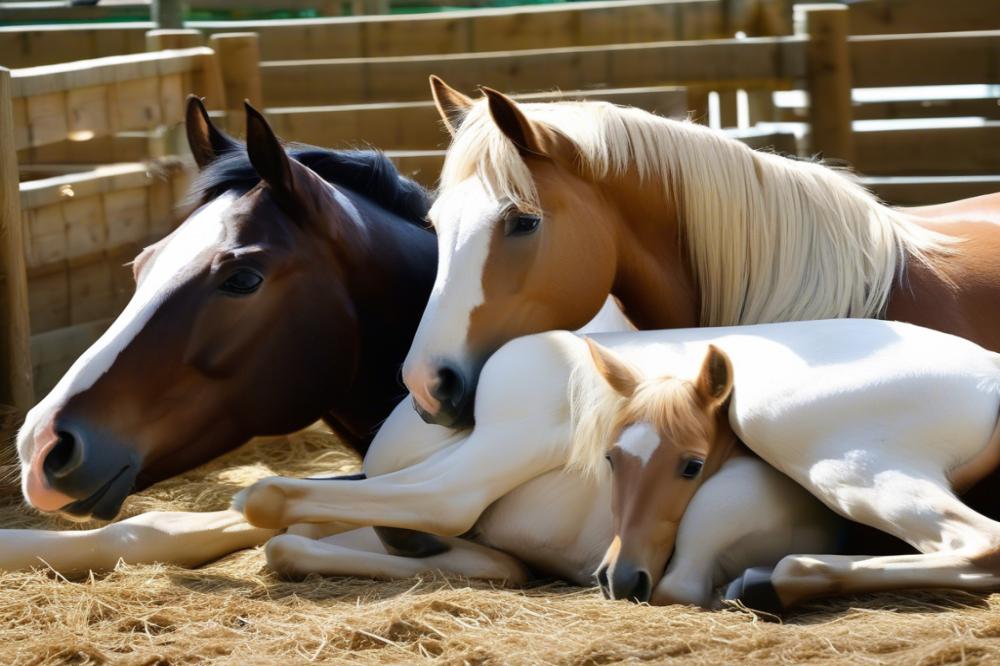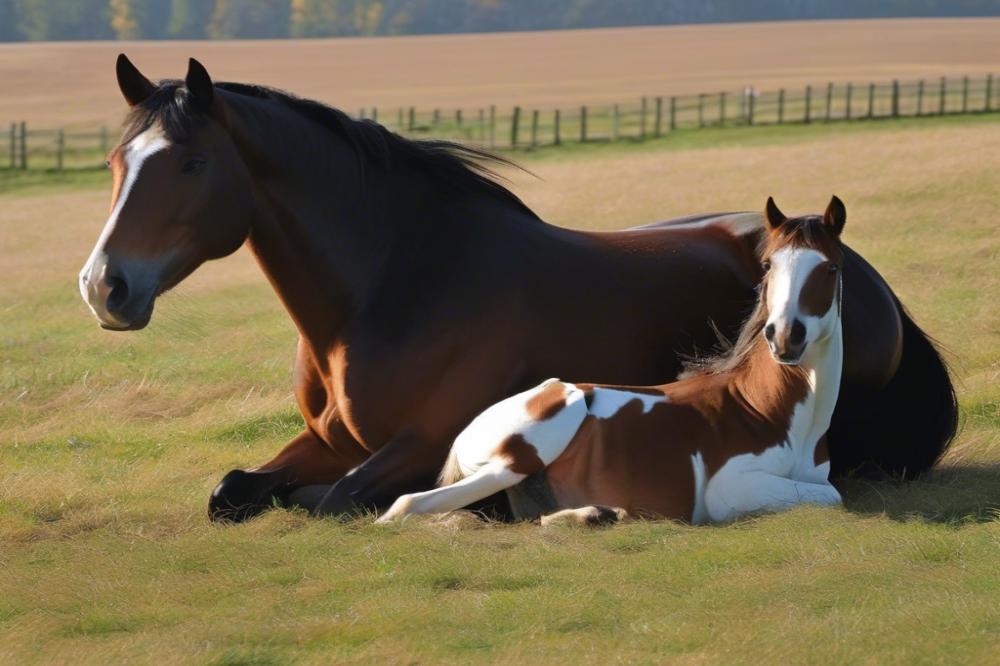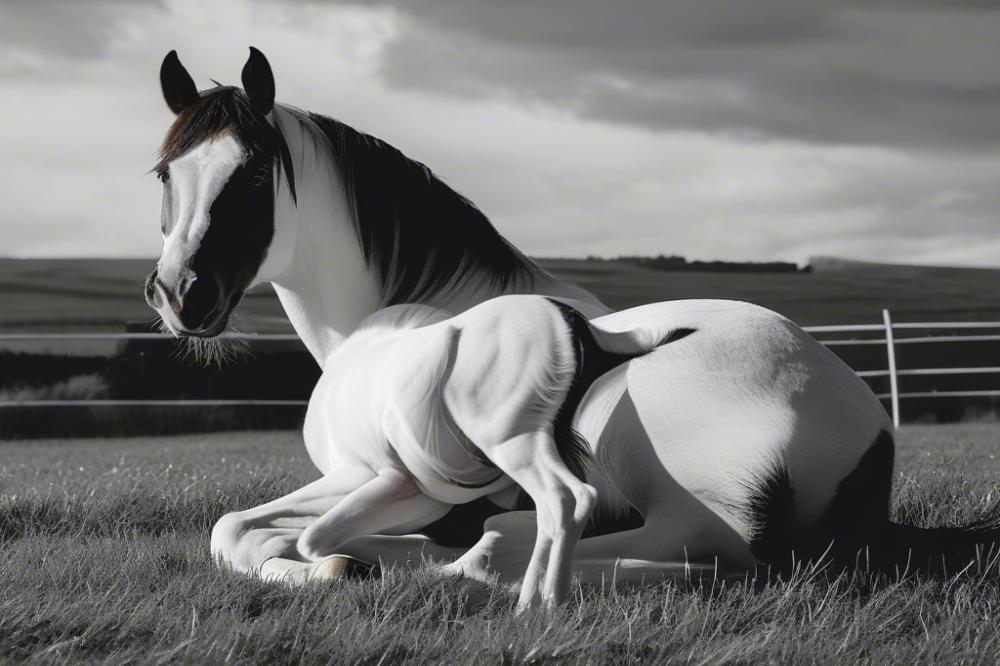Understanding the Miracle of Birth in Horses
When it comes to the wonder of nature, few events are as remarkable as the birth of a foal. Watching a mare give birth can feel like witnessing a finely orchestrated show, where everything unfolds in its own time. Yet, for those new to the world of equine care, the mysteries of the horse birth process might seem shrouded in confusion. You might wonder, do horses lay down to give birth? It’s a great question and a part of a bigger story about how we support these amazing creatures during such a critical moment in their lives.
Picture a serene meadow, where brown horses graze peacefully. Suddenly, one of them takes on a different stance, her body tense yet focused. Something magical is about to happen. Foaling, the term we use for the birthing process in horses, requires careful attention. For any horse owner, understanding this delicate stage not only enhances the safety of both mare and foal but also enriches the overall experience of raising these magnificent animals.
Anticipation during horse pregnancy often brings a mix of excitement and nerves. As the birthing day approaches, many owners dive deeper into mare care practices. Think of it like prepping for a big event—everyone wants to get it right. Ensuring the environment is calm and secure can mean the difference between a smooth delivery and a stressful situation. Plus, an educated approach contributes to better equine health, so both mare and foal can thrive from the get-go.
Some might not realize that not all mares handle foaling in the same way. Observing a roached back horse, for instance, can be quite a sight! This posture shows a mare nearing the actual birthing process. It’s fascinating how they prepare their bodies for what’s to come. After all, every horse has a unique birthing story filled with its own quirks and characteristics that make it special.
So whether you’re a seasoned horse person or a curious newcomer, grasping the ins and outs of the birthing process in horses will provide you with invaluable insights. By tapping into this knowledge, you’re not just preparing for a foal’s arrival; you’re also nurturing a lifelong bond with these remarkable animals.
Anatomy of the Horse Reproductive System

Let’s dive into the reproductive system of horses because understanding it helps us learn about the horse birth process. The main players in this process are the organs involved in equine reproduction. A mare’s reproductive organs include the ovaries, uterus, and vagina. Ovaries produce eggs, and the uterus is where the foal develops. It’s a cozy place for a young horse to grow. The vagina connects everything on the outside. Stallion anatomy differs quite a bit. They have testes that produce sperm, along with some tubes and glands. This duo of male and female systems comes together for a purpose—creating new life!
Differences between Mares and Stallions
When comparing mares and stallions, several key differences pop up. Stallions are commonly larger and more muscular. They also have a noticeable swagger. Mares possess a nurturing quality that’s apparent through their behaviors. Stallions usually play a role in mating, while mares are the ones who carry the foal. It’s clear that their roles are designed for specific tasks within equine health and breeding.
Role of the Placenta and Foal Development
As the mare’s pregnancy progresses, the placenta becomes essential for the foal. It acts like a lifeline, providing nutrients and oxygen while eliminating waste. Imagine it as a tent where the growing foal sleeps and munches on nutrients. This prenatal growth process can last around eleven months, though it varies. As the delivery date approaches, the mare prepares for foaling. During this time, mare care is crucial. Regular monitoring helps identify any issues. Understanding the entire pregnancy cycle is important for both the mare and the foal’s health. It’s a fascinating journey from conception to birth, full of changes and surprises.
The Process of Horses Giving Birth

Stages of Labor in Mares
Mares go through several distinct stages when they prepare to give birth. The first is called the preparatory stage. During this phase, the mare will start showing signs that labor is about to begin. She might act restless or pace around her stall, as if she knows something important is happening. Next comes the stage of active labor. This is when contractions begin, and the mare is really in the thick of it.
It’s during this time that you might see the mare lying down and getting up repeatedly. She may also start to sweat—a little bit of effort at work, if you will! The second stage usually lasts anywhere from 15 minutes to an hour. That’s when she will actually deliver the foal. After that, the third stage is all about the afterbirth. Yes, it’s a bit messy, but that’s just part of the horse birth process.
Signs That a Mare is About to Give Birth
Noticing changes in a mare can help you predict when she will foal. One obvious signal is a change in her belly. As horse pregnancy progresses, the mare’s abdomen will grow noticeably larger. Just before giving birth, her udder will fill with milk, sometimes causing it to drip.
Behavior also tells you a lot. Mares might start to isolate themselves, seeking a quiet place. They may also kick at their belly or exhibit signs of discomfort. Watching a mare closely can be a real eye-opener during this time. Keep your eyes peeled for any unusual activity, and don’t forget to be nearby—like a trusty sidekick ready for an adventure!
Duration and Typical Timeline of the Birthing Process
So, how long does the whole horse birth process take? Well, it varies greatly among mares. Generally, active labor can last from 20 minutes to a couple of hours. However, some may feel like they are taking their sweet time.
After the foal is born, the mare will often stay with her new little one, bonding and helping it stand. This part is crucial for both equine health and the foal’s survival. The first hour after birth is vital; the foal should nurse within that timeframe. Watch for the mare to clean the foal as well. That nurturing instinct kicks in pretty quickly!
In summary, a mare’s journey through giving birth is both beautiful and a touch chaotic. It’s like a rollercoaster ride for everyone involved! Understanding these stages can really help anyone who takes on mare care. Cue the excitement; foaling is like nature’s grand finale!
Do Horses Lay Down to Give Birth?

Common Myths About Horses and Birthing Positions
Many folks believe horses always stand when it’s time to give birth. This isn’t entirely true. Some think that being upright is the only way for a mare during labor. However, that’s just a misconception. In reality, laying down is quite common. It’s not just about comfort; there’s more to it. Some believe if a mare stands, she can run away quickly. While they might want to escape danger, the horse birth process can indeed be more relaxed on the ground.
Physiological Reasons for Laying Down During Labor
Physically, mares are built to deliver foals while lying down. When labor starts, muscle contractions help push the foal out. These contractions can be more effective when the mare is resting on her side or back. Gravity plays a role here too. Being horizontal helps with positioning. This way, the foal can maneuver out of the birth canal more easily. It’s nature’s design, ensuring everything proceeds smoothly.
Benefits of a Laying Down Position for the Mare and Foal
Several advantages come with a mare lying down during foaling. First, it lowers stress. Imagine if you had to give a big performance while standing! A calm environment helps both the mare and the foal. Additionally, the laying down position improves blood circulation, benefiting the foal. A healthy delivery also means better equine health post-birth. It’s like having a cozy place for the new arrival to come into the world. Lastly, it allows the mare to bond with her young one right after birth. Isn’t that sweet? In summary, laying down isn’t just a preference; it’s part of how nature intended horse pregnancy to unfold beautifully.
Post-Birth Care for Mare and Foal
Initial care immediately after birth
When a foal arrives, the excitement is palpable! The horse birth process can be messy, but it’s important to jump right in. After delivery, the mare usually takes a moment to catch her breath. You will want to gently check if her baby is up and moving.
Chances are, the little one will be wobbly at first. Trust me; that’s completely normal! They need to stand up soon after birth, as it’s crucial for their health. A sad reality is that some foals can struggle. Watching them take those first shaky steps is like seeing a toddler learn to walk for the first time.
Importance of colostrum and first nursing
Now, let’s talk about colostrum. This special milk is packed with antibodies, which help keep the foal strong. In the first hours after birth, it’s vital that the foal starts nursing. A healthy foal will usually seek to nurse within the first hour.
Without this crucial nutrient, the baby won’t have the best chance at a healthy start in life. Picture this: it’s like giving them a superhero cape! If the foal doesn’t nurse soon, the mare can be encouraged to help out by gently guiding her baby. Keep an eye on them. It’s amazing to see the bond forming right before your eyes.
Monitoring the mare’s health and recovery
Mare care does not stop after the foal arrives. Observing the mare’s health is just as important. Look for any signs of distress or complications. Sometimes, a mare might experience issues post-birth. These can include a lack of appetite or signs of pain.
Veterinary care might be necessary if anything seems off. Keeping the environment calm helps both the mare and foal settle in. Make sure she has plenty of clean water and hay. After all, a happy mare leads to a happy foal!
It’s fascinating how equine reproduction works. Both the mare and foal need support during this critical time. With the right care, they can flourish. Foaling calls for attention and love. Each mare and foal relationship is special, filled with moments of joy and wonder.
Factors Influencing the Birth Process
Environmental Factors Affecting Horses Giving Birth
When a mare is about to foal, her environment plays a big role. You wouldn’t want to give birth in a noisy place, right? Horses feel more secure in quiet, calm areas. A comfortable barn or a nice grassy field can make all the difference.
Temperature is another factor. Extremely hot or cold conditions can stress the mare. That stress can affect the horse birth process. A cozy space could help her relax and feel more at home. Lighting matters too. Too much brightness or too little can make a mare uneasy.
Role of Genetics and Breed-Specific Traits
Genetics also have a hand in how equine reproduction unfolds. Different breeds have various traits that affect foaling. For instance, some breeds are known for easier births than others. It’s a bit like people; some families have a history of smooth deliveries while others don’t.
Moreover, a mare’s lineage can give insights into how she might handle pregnancy and foaling. If her mom had complications, there might be a chance she could too. On the flip side, a strong lineage could suggest she’ll have a smoother time.
How Age and Health of the Mare Can Impact Birth
A mare’s age is crucial in the whole process. Younger mares might be too playful and restless during horse pregnancy, while older ones often have more experience. But age isn’t everything, as health is just as important. A mare in good shape usually has a better chance of a successful foaling.
Just think of it this way: a well-cared-for mare is like a well-tuned car; it’s more likely to run smoothly. If she has health issues, it could impact the entire foaling process. Regular vet check-ups can help make sure she’s in tip-top shape.
Common Issues During Birth
Recognizing Complications During Equine Birth
Foaling can be quite the event, full of excitement and, sometimes, drama. Some mares experience challenges during delivery. Knowing what to look for can be as important as preparing for a party. Signs of distress include excessive sweating, prolonged labor, or the foal’s positioning being off. Remember, a healthy mare is more likely to have a healthy foal. When things don’t seem right, being calm yet alert is critical. An owner’s intuition is often right; trust it!
Veterinary Interventions and Assistance
Veterinarians play a vital role in ensuring a safe horse birth process. They have the expertise to step in when complications arise. Sometimes, all it takes is a little guidance, while other times, medical intervention is necessary. A vet may assist in repositioning a stuck foal or provide medications to aid the mare. Having a plan in place before the big day helps reduce stress. Think of the vet as a backup dancer, ready to jump in if the main act needs support.
Long-term Outcomes for Mares and Foals
The outcome of a foaling can affect both the mare and her young one for years. If complications are properly handled, mares often recover quickly through proper mare care. Foals born under favorable circumstances tend to thrive and grow strong. However, any unaddressed issues during birth can lead to long-term health challenges. Equine health matters, and a watchful eye post-birth is essential. Regular check-ups with a vet can catch potential problems early. It’s like going for a health check; prevention is key!
Wrapping Things Up
Looking back at our exploration of how horses give birth, it’s clear that this process is not just a simple event. They typically lie down to deliver their foals, which helps in ensuring the safety and comfort of both the mare and her new baby. Many people are surprised to learn this fact. Horses are quite the remarkable animals, and their birthing rituals often reflect their instinctual need for a controlled environment.
Understanding the birthing process is essential for horse owners. A little bit of knowledge can go a long way. You wouldn’t want to be caught off guard at the moment of delivery, like stumbling into a surprise party without any cake! Preparing ahead of time and knowing the signs of labor can help you provide the utmost care for your mare. Whether you are a seasoned owner or a newcomer eager to dive into horse ownership—perhaps you’ve even picked up a book like “Dressage for Dummies”—being informed can make all the difference.
Being familiar with the ins and outs of foaling means you can create a nurturing space where both mother and foal can thrive. Imagine a horse hoof in the wild, instinctively knowing where to step next; this adaptability also exists in domestic settings. This doesn’t mean horses are without assistance during this critical time. Your guidance, support, and preparedness make the journey smoother for everyone involved.
In essence, taking the time to learn and prepare not only fosters a better environment for your horses but enhances your bond with them. Each experience offers a unique opportunity to grow as an owner and as a friend to these majestic creatures. Let your curiosity lead you, and you’ll find that the rewards of understanding horses go far beyond their beautiful forms. So dive in, educate yourself, and embrace this incredible experience with open arms!



